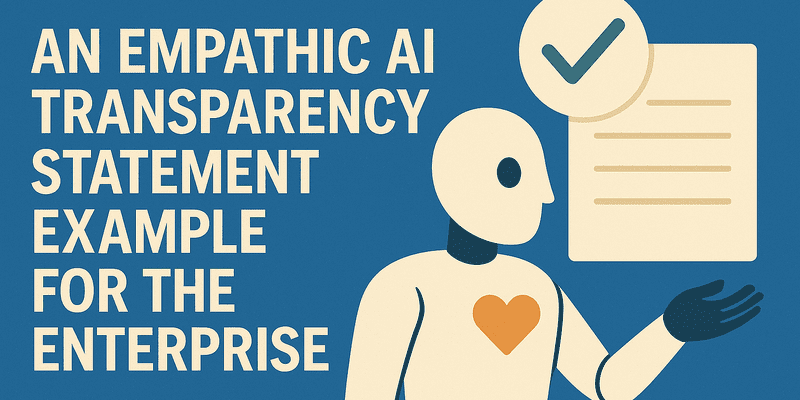An Empathic AI Transparency Statement Example for the Enterprise

Tim King offers insight on building an empathetic AI transparency statement in the enterprise, part of Solutions Review’s coverage on the human impact of AI.
In the age of intelligent machines, transparency is no longer a virtue—it’s a necessity. As artificial intelligence reshapes how decisions are made, services are delivered, and work is done, the need to show our hand—to explain what we’re doing, why we’re doing it, and who it affects—has never been greater. Transparency is the difference between trust and suspicion, between partnership and pushback. Without it, even the most advanced AI can feel like a black box of risk and alienation.
That’s why AI transparency is the beating heart of any Empathetic AI Framework. It’s the mechanism that turns lofty values into operational reality. It allows people—employees, customers, and stakeholders—to see the logic behind automation, understand how it touches their lives, and speak up when something feels off. It transforms AI from something done to people into something done with them in mind.
True AI transparency goes beyond vague commitments or sanitized press releases. It means being specific. What models are in use? What data are they trained on? Who was involved in building them? What human safeguards are in place? How are we checking for fairness, bias, or unintended consequences—and what happens when something goes wrong?
In an empathetic AI strategy, transparency is not a one-time disclosure—it’s a living promise. It’s the foundation that enables every other pillar: ethical oversight, fairness auditing, employee engagement, and cultural trust. Without it, empathy is performative. With it, empathy becomes systemic.
In short, if we want people to believe that AI can be deployed responsibly, we must show them how it works—clearly, honestly, and continuously. Because trust can’t be coded. It must be earned.
Empathic AI Transparency Statement Example
Why We Use AI
We embrace artificial intelligence not as a substitute for human judgment, but as a tool to support, augment, and elevate the people we serve—inside and outside the organization. We use AI to solve real-world problems at scale, streamline repetitive or time-consuming tasks, uncover insights buried in data, and enhance the overall efficiency and responsiveness of our services. But just as importantly, we use AI to create space for humanity—to free up our employees to do more meaningful work, to personalize experiences for our customers, and to make our systems more adaptive and inclusive.
From customer service to internal operations, our goal is never automation for its own sake. We evaluate every AI use case through a human-first lens: Does this system improve wellbeing? Does it expand opportunity? Does it align with our values of dignity, transparency, and fairness? When implemented with empathy and oversight, AI can be a force multiplier for good. But when done without thought, it can erode trust, displace livelihoods, and introduce harm.
That’s why our use of AI is always intentional, documented, and governed—not just for what it can do, but for how it does it and whom it serves.
Where We Use AI
We are deliberate and transparent about where artificial intelligence is applied within our operations. AI is not a blanket solution—it is a targeted tool deployed where it can meaningfully enhance human performance, reduce inefficiencies, and improve service quality without compromising empathy, accountability, or fairness.
Today, we use AI across a range of domains, including customer support systems that help us respond to inquiries more quickly and accurately, internal process automation that streamlines administrative tasks and reduces human error, and predictive analytics that help us anticipate operational needs, allocate resources, and make more informed decisions.
We also employ AI to detect potential risks—such as fraud or compliance violations—and to offer tailored experiences for users by analyzing contextual patterns in a privacy-respecting manner. Importantly, all of these deployments are reviewed through a governance lens to ensure they uphold our ethical standards. We do not allow AI to operate invisibly or unchecked in any part of our organization. Every use case is mapped, monitored, and evaluated not just by performance, but by its human impact.
This transparency allows us to stay accountable, adapt responsibly, and continuously improve the way we integrate technology into the core of our mission.
Human Oversight
Human oversight is a non-negotiable principle in every AI system we build, buy, or deploy. We do not believe that algorithms—no matter how sophisticated—should make high-stakes decisions without human involvement. That’s why we implement structured oversight mechanisms across the entire AI lifecycle, ensuring that people remain at the center of accountability.
For every AI application with material impact—whether on customers, employees, or public outcomes—we require a qualified human to be either “in the loop” (able to directly intervene before a decision is finalized) or “on the loop” (monitoring outcomes with authority to override or halt the system if necessary). This means that AI never operates in a vacuum or as an autonomous black box. Human reviewers are responsible for validating outcomes, flagging anomalies, assessing context, and ensuring that ethical and operational safeguards are being respected in real time.
Oversight personnel are trained in both the technical and ethical dimensions of the systems they supervise, and are empowered to escalate concerns when needed through clearly defined governance channels. By maintaining strong human oversight, we protect not only against errors and unintended consequences, but also against the erosion of trust that can occur when decisions feel opaque or automated without recourse.
At its core, this commitment reflects our belief that AI should support human judgment—not replace it—and that empathy, accountability, and context can never be fully automated.
AI System Explainability
We recognize that the power of artificial intelligence must be accompanied by clarity. That’s why explainability is a foundational requirement for every AI system we deploy. People deserve to understand how and why a system makes the decisions it does—especially when those decisions affect access to services, employment, compensation, or other matters with real human consequences.
We prioritize the use of explainable AI (XAI) techniques that allow both technical teams and non-technical stakeholders to grasp the inputs, logic, and reasoning behind algorithmic outputs. Wherever possible, we select models and architectures that balance performance with transparency, ensuring that decisions can be meaningfully interpreted, not just mathematically derived.
In cases where technical explainability is limited—such as with certain deep learning systems—we supplement with clear, plain-language summaries that outline the purpose of the system, the types of data it uses, the conditions under which it operates, and the potential impact on users. This includes making it easy for individuals to request explanations and challenge outcomes when appropriate. Explainability is not just a feature—it’s a safeguard.
It empowers users, builds trust, supports fairness auditing, and provides a foundation for accountability. Ultimately, our commitment to explainable AI reflects our broader goal: to ensure that technology works in a way people can understand, question, and trust.
Fairness & Bias Mitigation
We approach fairness and bias mitigation in AI not as a one-time task, but as a continuous responsibility that begins in system design and extends through real-world deployment. We understand that AI systems are only as fair as the data they’re trained on, the assumptions behind their models, and the decisions made by the humans who build and govern them.
That’s why every AI application we develop or procure undergoes rigorous pre-deployment fairness assessments. We analyze training data for representational imbalances, conduct bias testing across sensitive attributes like race, gender, age, and ability, and scrutinize use cases for any disproportionate impact on protected groups.
Our goal is not just to meet regulatory standards, but to uphold our own ethical commitment to equitable outcomes. Once systems are live, we conduct regular post-deployment audits to detect drift, unintended consequences, or emergent bias over time. These audits are documented, tracked, and used to inform system updates or retraining when necessary.
Importantly, we maintain clear records of how fairness trade-offs are handled, and we require that those decisions be made transparently and with stakeholder input when appropriate. In systems that materially affect individuals, we also ensure there is a pathway for appeal or redress, so that fairness is not only designed into the algorithm, but reflected in the lived experience of those it touches.
For us, bias mitigation is not about perfection—it’s about vigilance, humility, and a relentless commitment to doing right by the people our systems impact.
Workforce Impact Disclosure
We believe that responsible AI deployment includes being honest and proactive about how automation affects our workforce. As part of our Empathetic AI Framework, we commit to full transparency around any AI implementation that may alter, displace, or transform human roles.
We understand that the integration of AI into operations can create efficiency, but it can also create uncertainty—and people deserve clarity, not surprises. That’s why we disclose, internally and when appropriate externally, whether an AI system has the potential to impact employment structures, job functions, or team dynamics.
For every such deployment, we evaluate human impact through a structured review process and communicate the findings clearly to affected employees. We prioritize “augmentation over automation,” seeking to use AI to support workers rather than replace them. But when changes are unavoidable, we provide fair notice, reskilling and upskilling opportunities, and support pathways to new roles within the organization wherever possible.
We also track and report workforce impact metrics to ensure we are not only meeting ethical intentions but delivering on them. Our workforce is not an afterthought in digital transformation—it is the heart of our success. That’s why we believe automation must come with empathy, foresight, and a commitment to shared progress.
Redress & Appeal
We believe that no AI system should be above question—and no individual should be left without recourse. That’s why we’ve built formal redress and appeal mechanisms into every aspect of our AI governance strategy. If an AI-assisted decision affects an employee, customer, or stakeholder—especially in sensitive areas such as hiring, promotions, credit evaluation, healthcare, or access to services—those individuals have the right to understand the decision and to challenge it.
We provide clear, accessible pathways for requesting a human review of any AI-influenced outcome, along with the right to receive a plain-language explanation of how the decision was made. Our appeals process is managed by trained personnel who are not only technically competent but also empowered to override or reverse AI decisions when appropriate.
Additionally, we operate an internal AI Ethics Concern form, which allows employees or external users to flag issues, report potential harms, or express concerns anonymously if desired. Every concern is tracked, investigated, and used as input for improving system design and oversight procedures. We do not view redress as a burden—it is a critical safeguard that keeps people in control of their outcomes.
In an empathetic AI framework, justice must remain a human right, not an algorithmic assumption. This commitment ensures that our systems serve individuals with dignity and respect, and that trust in AI is earned through real accountability.
Transparency in Procurement
Our commitment to empathetic AI doesn’t stop at the systems we build—it extends to the systems we buy. That’s why we enforce transparency in procurement as a core component of our responsible AI strategy. Every third-party AI product or service we integrate must meet clearly defined ethical, technical, and governance standards.
We require vendors to provide documentation that outlines how their systems are developed, what data they are trained on, what fairness and bias testing has been conducted, and how human oversight is maintained. We do not engage with “black box” solutions that cannot be audited, explained, or aligned with our values. During procurement, we assess not only performance capabilities, but also risk factors related to safety, privacy, explainability, and potential workforce impact. Our contracts include clauses that mandate compliance with our Empathetic AI Framework, including the right to review model logic, conduct audits, and halt use if ethical red flags are identified. In some cases, we may request third-party assessments of vendor tools or include them in our internal ethics review process. By applying the same scrutiny to external tools as we do to our own, we ensure that empathy and accountability travel with every algorithm we deploy—whether it originates inside our organization or comes from a partner. Transparency in procurement is how we protect our people, our stakeholders, and our values from the inside out.
Continuous Improvement
We understand that ethical AI is not a destination—it’s a discipline. That’s why continuous improvement is a defining feature of our Empathetic AI Framework. The AI landscape evolves rapidly, and so do the societal expectations, legal standards, and lived realities of the people our systems affect. What is responsible today may not be sufficient tomorrow.
To stay ahead, we conduct regular reviews of all deployed AI systems, update governance policies as new insights emerge, and actively scan the horizon for early signals of risk or harm. Our internal teams, including ethics, compliance, data science, and human resources, collaborate to ensure feedback from audits, user reports, redress outcomes, and post-deployment monitoring feeds directly into system updates and organizational learning.
We also publish an Annual Empathetic AI Report that transparently documents our deployments, impact metrics, audit findings, and improvements made—because accountability requires more than good intent; it requires visible progress. We encourage employees at all levels to participate in identifying gaps, suggesting safeguards, and proposing new practices that align with our core values of fairness, dignity, and trust. Continuous improvement is not a checkbox for us—it’s a culture.
It reflects our belief that the best way to earn trust in a world shaped by intelligent machines is to never stop listening, learning, and adapting.
Note: These insights were informed through web research and generative AI tools. Solutions Review editors use a multi-prompt approach and model overlay to optimize content for relevance and utility.



